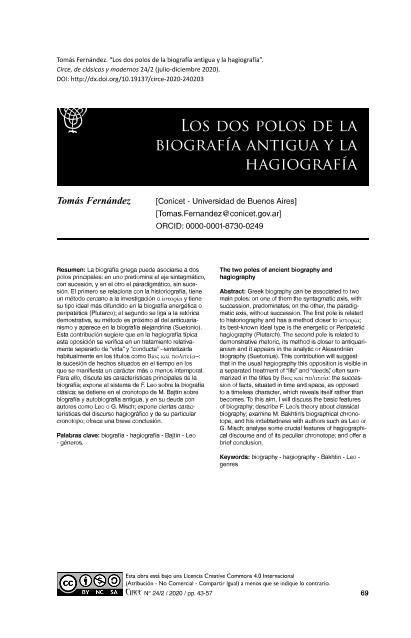Mostrar el registro sencillo del ítem
dc.contributor.author
Fernández, Tomás

dc.date.available
2022-09-23T16:04:12Z
dc.date.issued
2020-12-09
dc.identifier.citation
Fernández, Tomás; Los dos polos de la biografía antigua y la hagiografía; Universidad Nacional de La Pampa. Instituto de Estudios Clásicos; Circe, de clásicos y modernos; 24; 2; 9-12-2020; 43-57
dc.identifier.issn
1514-3333
dc.identifier.uri
http://hdl.handle.net/11336/170259
dc.description.abstract
La biografía griega puede asociarse a dos polos principales: en uno predomina el eje sintagmático, con sucesión, y en el otro el paradigmático, sin sucesión. El primero se relaciona con la historiografía, tiene un método cercano a la investigación o ἱστορία y tiene su tipo ideal más difundido en la biografía energética o peripatética (Plutarco); el segundo se liga a la retórica demostrativa, su método es próximo al del anticuarianismo y aparece en la biografía alejandrina (Suetonio). Esta contribución sugiere que en la hagiografía típica esta oposición se verifica en un tratamiento relativamente separado de “vida” y “conducta” –sintetizada habitualmente en los títulos como Βίος καὶ πολιτεíα–: la sucesión de hechos situados en el tiempo en los que se manifiesta un carácter más o menos intemporal. Para ello, discute las características principales de la biografía; expone el sistema de F. Leo sobre la biografía clásica; se detiene en el cronotopo de M. Bajtín sobre biografía y autobiografía antigua, y en su deuda con autores como Leo o G. Misch; expone ciertas características del discurso hagiográfico y de su particular cronotopo; ofrece una breve conclusión.
dc.description.abstract
Greek biography can be associated to two main poles: on one of them the syntagmatic axis, with succession, predominates; on the other, the paradigmatic axis, without succession. The first pole is related to historiography and has a method closer to ἱστορία; its best-known ideal type is the energetic or Peripatetic hagiography (Plutarch). The second pole is related to demonstrative rhetoric, its method is closer to antiquarianism and it appears in the analytic or Alexandrian biography (Suetonius). This contribution will suggest that in the usual hagiography this opposition is visible in a separated treatment of “life” and “deeds”, often summarized in the titles by Βίος καὶ πολιτεíα: the succession of facts, situated in time and space, as opposed to a timeless character, which reveals itself rather than becomes. To this aim, I will discuss the basic features of biography; describe F. Leo’s theory about classical biography; examine M. Bakhtin’s biographical chronotope, and his indebtedness with authors such as Leo or G. Misch; analyse some crucial features of hagiographical discourse and of its peculiar chronotope; and offer a brief conclusion.
dc.format
application/pdf
dc.language.iso
spa
dc.publisher
Universidad Nacional de La Pampa. Instituto de Estudios Clásicos
dc.rights
info:eu-repo/semantics/openAccess
dc.rights.uri
https://creativecommons.org/licenses/by-nc-sa/2.5/ar/
dc.subject
HAGIOGRAFÍA
dc.subject
BIOGRAFÍA ANTIGUA
dc.subject
BAJTÍN
dc.subject
MOMIGLIANO
dc.subject.classification
Lenguajes Específicos

dc.subject.classification
Lengua y Literatura

dc.subject.classification
HUMANIDADES

dc.title
Los dos polos de la biografía antigua y la hagiografía
dc.title
The two poles of ancient biography and hagiography
dc.type
info:eu-repo/semantics/article
dc.type
info:ar-repo/semantics/artículo
dc.type
info:eu-repo/semantics/publishedVersion
dc.date.updated
2022-09-23T15:39:44Z
dc.identifier.eissn
1851-1724
dc.journal.volume
24
dc.journal.number
2
dc.journal.pagination
43-57
dc.journal.pais
Argentina

dc.journal.ciudad
Santa Rosa de La Pampa
dc.description.fil
Fil: Fernández, Tomás. Universidad de Buenos Aires. Facultad de Filosofía y Letras. Instituto de Filología Clásica; Argentina. Consejo Nacional de Investigaciones Científicas y Técnicas; Argentina
dc.journal.title
Circe, de clásicos y modernos
dc.relation.alternativeid
info:eu-repo/semantics/altIdentifier/url/https://cerac.unlpam.edu.ar/index.php/circe/article/view/5478
dc.relation.alternativeid
info:eu-repo/semantics/altIdentifier/doi/http://dx.doi.org/10.19137/circe-2020-240203
Archivos asociados
